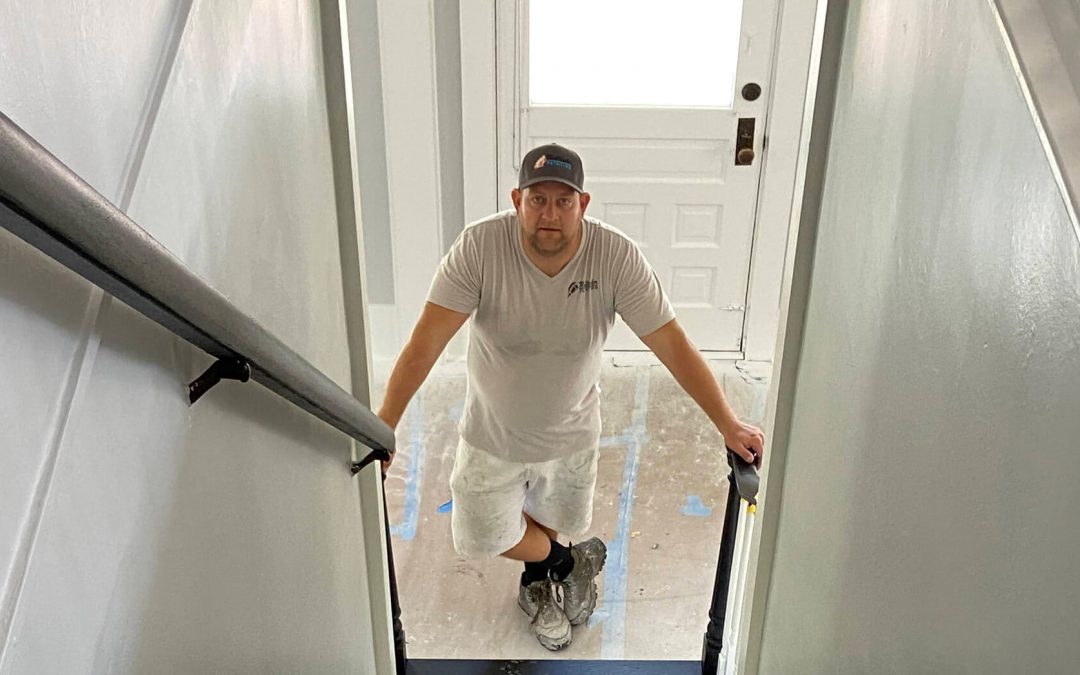As a homeowner or DIY enthusiast, you may be wondering how long it takes for interior paint to dry. Interior painting is a cost-effective way to transform your living space, but it can be a frustrating experience if you don’t know the correct drying time.
After the pre-painting preparations, the process is usually quick; that is until after the first coat of paint is applied to the walls. The process then comes to a halt because you must wait for the first coat to dry before applying another layer.
How long should I wait and what is the optimum drying time between coats? I will provide you with these answers and tips on how you can reduce the drying time so that your furniture and pictures can be put back in place as soon as possible.
Drying time after the first coat is usually 2-4 hours
When the first coat of paint has been applied and the room is already looking nice and clean, it is very tempting to move the furniture back into place. At this point, however, it’s important not to rush things. Always wait until the paint is completely dry before applying the next coat!
Drying time is generally 2-4 hours, but it’s safer to let the walls to dry overnight. The next day, make sure the previous coat of paint has fully dried and then you can paint the second coat.
Drying time also depends on humidity and temperature
High humidity makes drying more difficult as well as cooler weather. Both humidity and low temperatures can drastically extend the drying time of the paint. For this reason, the recommended drying time of 2-4 hours can sometimes be too short. The time it takes for the paint to dry depends on the type of paint used and the environment it is used in. Therefore, it is always a good idea to read the paint application directions before use.
Factors That Affect Interior Paint Drying Time
There are several factors that affect how long it takes for interior paint to dry, including:
- Humidity: High humidity levels can slow down the drying process, while low humidity levels can speed it up. If you live in a humid environment, consider using a dehumidifier to help dry the paint.
- Temperature: The ideal temperature range for painting and drying is between 60-80°F. Higher temperatures can cause the paint to dry too quickly, leading to cracking and peeling. On the other hand, lower temperatures can slow down the drying process.
- Ventilation: Proper ventilation is vital to ensure efficient drying of interior paint. Good airflow helps remove moisture from the paint, allowing it to dry faster. Opening windows and using fans or air circulation systems can significantly aid the drying process. However, be cautious of introducing dust or debris into the area while ensuring adequate ventilation.
- Type of paint: Different types of paint have different drying times. Latex paint, for example, can take anywhere from 30 minutes to an hour to dry, while oil-based paint can take up to 24 hours.
- Paint thickness: Thicker coats of paint will take longer to dry than thin coats. If you want your paint to dry faster, consider applying several thin coats rather than one thick coat.
What happens if you apply a second layer of paint before the first has fully dried?
What could go wrong, right? Many people like to rush when interior painting – wanting the project to be finished as soon as possible. Usually, problems are not immediately obvious. Of course, if you do not wait the minimum of 2-4 hours for the second coat, the roller can loosen the first layer in patches, although it may not be immediately visible.
Typically, it is more common to paint the second coat after a few hours of drying, but not wait for it to dry completely. In this case, it will take a few weeks or months before the defect is visible in the form of cracks. Unfortunately, less experienced professionals commonly make this mistake.
I am always surprised when I’m called to a newly painted house to make an estimate or offer. As the layers of paint slowly dry, cracks appear. First just hairline, then thicker, more visible cracks. Clearly, the previous painter did not wait for the paint to dry completely between coats.
Hindsight, homeowners who find themselves in this predicament will realize how much more it costs to repaint the walls rather than waiting an extra day for the paint to fully dry. Additionally, it’s so important to choose the right time to paint. For example, when painting during the rainy season, humidity is very high, and you should expect longer drying times.
Paint types and drying time
If the weather is ideal, all you need to consider is the type of paint. Identify what you are painting with: are you using a water-based latex or oil-based paint?
There are a few rules of thumb to help you get started:
- Water-based paint dries faster than oil-based paint
- Flat paint dries faster than glossy paint
- Paint applied with a roller dries faster than paint applied with a brush because it spreads the paint in thinner layers.
- Lighter colors dry faster than darker colors.
If you used oil paint, gloss paint or paint applied in a thicker coat as with a brush, wait 24 hours before applying the second coat.
How do you know if the previous coat of paint has dried?
A simple touch test will suffice! Simply touch the wall with clean, dry hands. If your hands stay dry and clean and you do not feel any cold moisture, the paint has dried. Do the test in several places. There may be areas that take longer to dry, such as corners.
Important: drying time and curing time are not the same! That is, if you find the wall dry a few hours after the last coat of paint, the paint has still not fully set. It will take a few days or a few weeks for the paint to cure completely, again depending on the weather. Before this time, the paint is dry but still vulnerable, i.e. it will still be susceptible to scratching.
Here is some very important information regarding removed furniture. If you do not have time to wait a few days, be very careful and watch out for the fresh wall paint! Try not to have the furniture touch or brush past the wall right away. It is worth waiting a week before putting back paintings and wall art.
How can the drying process be accelerated?
With ventilation. There is not any other way. However, you can optimize the workflow so that there are no idle drying times. Use time management: it is beneficial to paint several rooms at once. This way, while you are working on one room, the walls of the other room can dry.
Plan your workflow in advance, believe me, it will save you so much extra time!
How Long Does Interior Paint Take to Dry: FAQs
To further clarify the intricacies of interior paint drying, let’s address some frequently asked questions:
1. How long does it take for interior paint to fully dry?
Complete drying of interior paint typically takes around two weeks. During this time, the paint goes through a curing process, becoming more durable and resistant to damage. While the paint may be dry to the touch within a few hours, it’s essential to avoid heavy use or cleaning until the paint has fully cured.
2. Can I speed up the drying process of
While it’s not recommended to rush the drying process, there are a few techniques that can help expedite it. First, ensure proper ventilation by opening windows or using fans. You can also lower the humidity levels in the room by using a dehumidifier. Additionally, keeping the temperature within the optimal range of 50°F to 85°F can aid in faster drying.
3. How can I tell if the paint is dry to the touch?
To determine if the paint is dry to the touch, lightly press a finger against an inconspicuous area of the painted surface. If it feels dry and doesn’t leave any residue on your finger, it is likely dry. However, it’s important to remember that complete curing takes longer.
4. What happens if I apply a second coat of paint before the first coat is fully dry?
Applying a second coat of paint before the first coat is dry can result in various issues. The topcoat may not adhere properly, leading to uneven texture and potential peeling or cracking. It’s crucial to follow the recommended drying times between coats to achieve a smooth and durable finish.
5. Does the color of the paint affect drying time?
In general, the color of the paint does not significantly impact drying time. However, darker shades may take slightly longer to dry due to the higher concentration of pigments. The difference, though, is usually minimal and not noticeable under normal circumstances.
6. Can I apply paint in cold weather?
Cold weather can significantly prolong the drying time of interior paint. It’s best to avoid painting in temperatures below 50°F as it can lead to improper drying and compromised paint quality. If you must paint in colder conditions, use specialized paints designed for lower temperatures and ensure adequate ventilation.
If you do not want to bother with drying times and would rather leave the interior wall painting to an experienced professional painter, please contact us! I work with professional quality paints and varnishes in the Saint Augustine area, and I would be happy to give your home a new look!
Call for a free quote – I am available at short notice! 1(904)217-9681
Related blog articles:
Three Steps to a Successful Home Renovation
Wall Painting Tools And Equipment – What You Will Need For Interior Wall Painting


